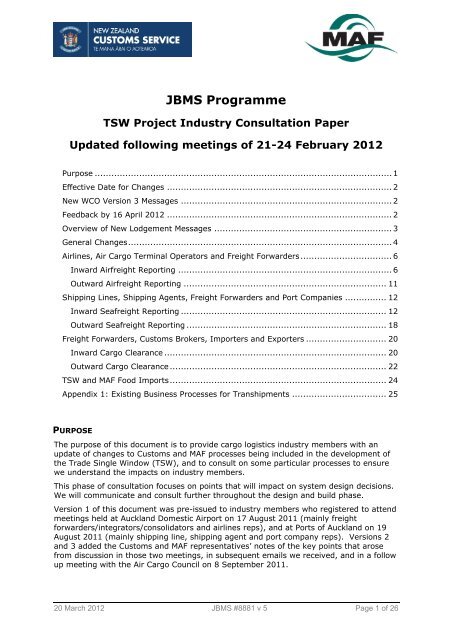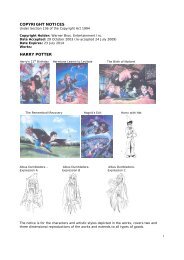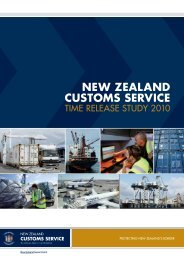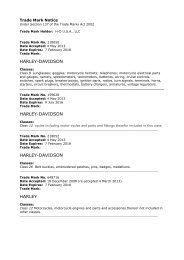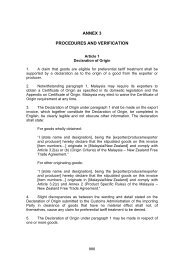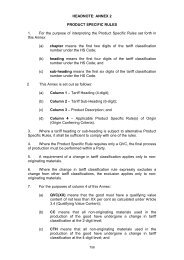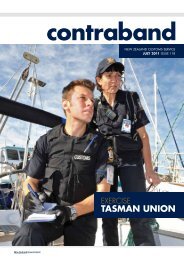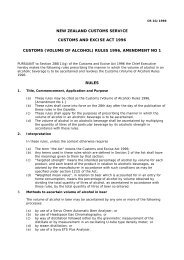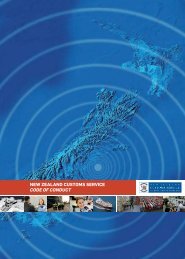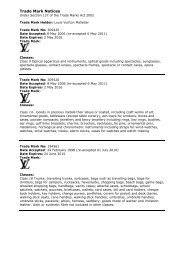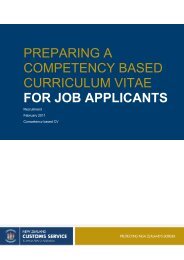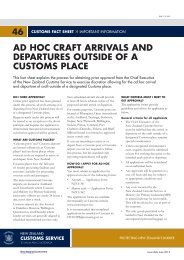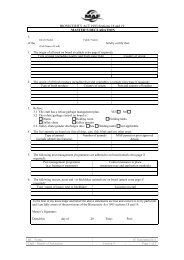TSW Project Industry Consultation Paper - New Zealand Customs ...
TSW Project Industry Consultation Paper - New Zealand Customs ...
TSW Project Industry Consultation Paper - New Zealand Customs ...
- No tags were found...
You also want an ePaper? Increase the reach of your titles
YUMPU automatically turns print PDFs into web optimized ePapers that Google loves.
JBMS Programme<strong>TSW</strong> <strong>Project</strong> <strong>Industry</strong> <strong>Consultation</strong> <strong>Paper</strong>Updated following meetings of 21-24 February 2012Purpose ........................................................................................................... 1Effective Date for Changes ................................................................................. 2<strong>New</strong> WCO Version 3 Messages ............................................................................ 2Feedback by 16 April 2012 ................................................................................. 2Overview of <strong>New</strong> Lodgement Messages ................................................................ 3General Changes............................................................................................... 4Airlines, Air Cargo Terminal Operators and Freight Forwarders................................. 6Inward Airfreight Reporting ............................................................................. 6Outward Airfreight Reporting ......................................................................... 11Shipping Lines, Shipping Agents, Freight Forwarders and Port Companies ............... 12Inward Seafreight Reporting .......................................................................... 12Outward Seafreight Reporting ........................................................................ 18Freight Forwarders, <strong>Customs</strong> Brokers, Importers and Exporters ............................. 20Inward Cargo Clearance ................................................................................ 20Outward Cargo Clearance .............................................................................. 22<strong>TSW</strong> and MAF Food Imports.............................................................................. 24Appendix 1: Existing Business Processes for Transhipments .................................. 25PURPOSEThe purpose of this document is to provide cargo logistics industry members with anupdate of changes to <strong>Customs</strong> and MAF processes being included in the development ofthe Trade Single Window (<strong>TSW</strong>), and to consult on some particular processes to ensurewe understand the impacts on industry members.This phase of consultation focuses on points that will impact on system design decisions.We will communicate and consult further throughout the design and build phase.Version 1 of this document was pre-issued to industry members who registered to attendmeetings held at Auckland Domestic Airport on 17 August 2011 (mainly freightforwarders/integrators/consolidators and airlines reps), and at Ports of Auckland on 19August 2011 (mainly shipping line, shipping agent and port company reps). Versions 2and 3 added the <strong>Customs</strong> and MAF representatives’ notes of the key points that arosefrom discussion in those two meetings, in subsequent emails we received, and in a followup meeting with the Air Cargo Council on 8 September 2011.20 March 2012 JBMS #8881 v 5 Page 1 of 26
In version 4, the layout was amended to set out the content under headings for eachstakeholder group, while retaining discussion points from previous meetings. Updates onoutstanding matters for final consultation were shown, along with some clarifications andcorrections. It was pre-published for discussion at consultation meetings held inAuckland, Christchurch and Wellington over 21-24 February 2012.This version 5 records what <strong>Customs</strong> and MAF consider to be the accepted approachresulting from those meetings, with a summary of consultation for key elements. As withprevious versions, it will be published on the Border Sector page of <strong>Customs</strong>’ website forgeneral feedback. It will also be provided to industry representative bodies for feedback,before being submitted for discussion at the 18 th April 2012 meeting of the Tomorrow’sCargo Logistics forum. Agency procedures will be finalised following that meeting.EFFECTIVE DATE FOR CHANGESUnless otherwise indicated, the procedure changes will be introduced gradually asindustry members start to adopt the new cargo reporting messages outlined below.These new cargo reporting messages will be mandated 18 months after <strong>TSW</strong> goes live.This adoption period was requested by industry during 2009 consultation. We expect<strong>TSW</strong> to go live in the first quarter of 2013, meaning the new messages (and thereforemost of the new procedures) will be mandatory from around mid 2014. The impact ofthe changed procedures will be monitored along the way to ensure they achieveagencies’ objectives and do not create unmanageable difficulties for the industry.NEW WCO VERSION 3 MESSAGESThe new messages do involve new data elements, but in most cases these are to do withtechnical transmission information, or involve optional new information to facilitateclearance. Draft versions of the Message Implementation Guidelines are currentlyavailable online. These will be finalised over the next few months, when final versionswill be published.FEEDBACK BY 16 APRIL 2012<strong>Industry</strong> members are encouraged to provide any feedback on this document tojbms@customs.govt.nz or to their industry representative body by 16 April 2012 so thatany final concerns can be considered before the Tomorrow’s Cargo Logistics meeting on18 April 2012.20 March 2012 JBMS #8881 v 5 Page 2 of 26
OVERVIEW OF NEW LODGEMENT MESSAGESThe following table provides a summary of the lodgements discussed in this document:Lodgement Abbreviation CommentAdvance Notice ofArrivalANAFax and email submission replaced by new*WCO3-based message submissible viamessaging or web channelFor commercial vessels, incorporates InwardReport information if known, precluding the needfor an Inward ReportANA will not be required for scheduled commercialaircraft - agencies will instead reuse the API ANAfor <strong>TSW</strong> purposes, where availableInward Cargo Report(including low valueimports clearance)InternationalTranshipment RequestDomestic TranshipmentRequestICRITRDTR<strong>New</strong> WCO3-based message incorporating MAFBACC data<strong>New</strong> requirement for airlines to report all cargo onboard at master and house level detail<strong>New</strong> requirement for an ICR for sea freightconsolidation/FAK/LCL shipments<strong>New</strong> requirement for positive indication that lowvalue write-off is requestedReplaces <strong>Customs</strong>’ Transhipment for Exportmessages within ICR or via ECI<strong>New</strong> WCO3-based message incorporating MAFrisk dataaka “Under Bond Cargo”Electronic submission via messaging or webchannel replaces <strong>Customs</strong>’ “<strong>Paper</strong>lessTranshipments” and hard copy “Permit to Remove”<strong>New</strong> WCO3-based message incorporating MAFBACCA dataImport Declaration Import Dec <strong>New</strong> WCO3-based message incorporating MAFBACCA dataExport Declaration Export Dec <strong>New</strong> WCO3-based messageCargo Report Export(low value exportclearance)Advance Notice ofDepartureCREAND<strong>New</strong> WCO3-based messageElectronic submission via messaging or webchannel<strong>New</strong> WCO3-based message based on <strong>Customs</strong>’Outward Report formOutward Cargo Report OCR <strong>New</strong> WCO3-based messageExcise Declaration Excise Dec <strong>New</strong> WCO3-based message - minimal change*World <strong>Customs</strong> Organisation Data Model Version 320 March 2012 #8881 JBMS <strong>TSW</strong> <strong>Industry</strong> <strong>Consultation</strong> Page 3 of 26
GENERAL CHANGESThere are a few points for all industry members to note:a. All lodgements will be submissible via messaging or the web channel, andwe are developing capability for lodgements made by messaging to be adjustedand viewed via the web channel.b. All lodgements will be submissible in both the XML and EDIFACT format.However, attachments are only possible in XML, so EDIFACT messagingclients will need to submit attachments to a lodgement via the web channel.<strong>Consultation</strong> summary:i. At the first consultation meetings, airline reps asked if the IATA format wouldbe accepted by <strong>TSW</strong>. JBMS reps advised it would not, as it requires significanteffort to enable transformation into the WCO3 format. We are not aware ofother administrations accepting the Cargo-IMP format; EDIFACT and XML arethe international standards for administration and trade, which areadministered by UN/CEFACT.ii.iii.iv.In addition, we received advice from IATA that it is envisioned the Cargo-IMPedition of 2014 will be the last, and it would not amend Cargo-IMP as of thatdate as IATA is encouraging the industry to move to XML, and promotes<strong>Customs</strong> messages being pushed to <strong>Customs</strong>, not trade and transportmessages. Airlines and the air cargo community will still be free to use Cargo-IMP, and it will probably continue to be used for some time as it is a big part ofthe airlines' legacy systems. However, typically service providers providerelays as well as translation services, so an airline may continue to sendCargo-IMP messages to their service provider who can then map theinformation into the message format that <strong>Customs</strong> requires.So for the <strong>New</strong> <strong>Zealand</strong> <strong>TSW</strong>, airlines can either transform their messages intothe WCO EDIFACT/XML messages, or continue to use ECN or another messagetransformation service to do this.The Air Cargo Council advised they had checked with overseas systemsexperts who advised this is what occurs elsewhere, and they see no problemwith the requirement.c. As signalled in 2009 consultation, electronic “delivery orders” will bemandated. This means any party requiring <strong>Customs</strong> or MAF approval to releasegoods (whether final or conditional release) from their premises (e.g. <strong>Customs</strong>Controlled Areas and MAF Transitional Facilities), must be capable of receiving<strong>TSW</strong> response messages electronically i.e. via messaging, the web channel, oremail. <strong>Customs</strong> and MAF indicated in earlier consultation that we would like tomandate electronic “delivery orders” from the <strong>TSW</strong> go-live date (expected in thefirst quarter of 2013).<strong>Consultation</strong> summary:i. While it’s our preference to achieve early mandating of electronic deliveryorders, analysis indicates it would be too problematic. At this stage, our planis to see how it goes when <strong>TSW</strong> goes live, and revisit this matter if the use ofan array of printed <strong>Customs</strong> delivery orders and MAF instructions, combinedwith gradual uptake of electronic delivery orders for new messages, is causingissues. At the latest, electronic delivery orders will be mandated when the newWCO version 3 messages become mandatory (expected around mid 2014, asdiscussed on page 2 above).20 March 2012 #8881 JBMS <strong>TSW</strong> <strong>Industry</strong> <strong>Consultation</strong> Page 4 of 26
d. We identified the desirability of a common voyage or flight identifier to beshown on notices, reports, movements and declarations to facilitate accuratereconciliation of these submissions to ensure all cargo is reported and movedaccording to <strong>Customs</strong> and MAF instructions. For seafreight, we are aware thevoyage number can vary between the prime carrier and space sharing carriers, sowe proposed using the vessel code plus the prime carrier’s voyage number. Forairfreight, we are aware the flight number can vary between the prime carrier andcode-sharer carriers, so we proposed using the prime carrier’s flight number andthe arrival date.<strong>Consultation</strong> summary:i. Shipping and airline industry meetings advised there are obstacles to the airand sea identifiers we proposed. The voyage/flight number used by the spacesharershipping line/code-sharing airline is what is advised on the bill oflading/air waybill, so is all that is known by the consignor, consignee andfreight forwarder. <strong>Industry</strong> reps considered there would be real difficulties intrying to communicate the prime carrier’s voyage/flight number across thevarious parties involved. Agency reps recognised the issue and undertook tolook into what other administration do, which did not identify a solution. As aresult, <strong>Customs</strong> and MAF agreed that <strong>TSW</strong> will accept all code share identifiersand voyage numbers, and we will map these for cargo reconciliation asnecessary.e. The reporting period for uncleared cargo was a new item <strong>Customs</strong> and MAFadded for discussion at the 21-24 February meetings. The current procedure formonthly reporting of uncleared cargo to <strong>Customs</strong> by <strong>Customs</strong> Controlled Areas(CCAs) means <strong>Customs</strong> may not be advised for up to 46 days after importationthat the goods have not been cleared, which undermines risk management. Whilecargo reconciliation introduced with <strong>TSW</strong> will contribute to improving this, it willtake quite a while to get this working well, and we are likely to still require CCAreporting anyway.<strong>Consultation</strong> summary:i. We sought feedback on what is the minimum period CCAs could cope with.The general consensus was that it is rare for cargo not to be cleared within 14days of importation, so it would be acceptable to require reporting of all cargoremaining uncleared 14 days after importation. <strong>Customs</strong> and MAF undertookto consult with large CCAs such as Tappers before making this change.f. Additional seafreight matters discussed at the February 2012 shipping andports meeting were:i. Bulk change upload: The <strong>TSW</strong> includes the ability for a shipping company toadvise <strong>Customs</strong> and MAF of a change of port of discharge/loading or a changeof ship, and for <strong>Customs</strong> to generate a “bulk upload” of the new information.This will enable all transhipment approvals and import and export deliveryorders associated with the change to be amended and re-transmitted to thenew port of loading/discharge.ii.Data from ICRs provided to ports: Agency reps advised that portcompanies were keen to receive data from carrier ICRs that could help informport logistics, and asked if shipping companies had any concerns about anyparticular information being proved. Shipping company reps confirmed theyhad no concerns. Agency reps undertook to hold a workshop with ports toconfirm data of interest – this will be scheduled once work on the messages tomeet project deadlines is complete.20 March 2012 #8881 JBMS <strong>TSW</strong> <strong>Industry</strong> <strong>Consultation</strong> Page 5 of 26
AIRLINES, AIR CARGO TERMINAL OPERATORS AND FREIGHT FORWARDERSInward Airfreight ReportingReconciliationacross ANA,ICRs, Requests,and Declarationsis conducted atregular intervalsto ensure allunloaded goodsare cleared1. Advance Notice of Arrival (ANA)a. Submitted by the person in charge of a craft, or the operator/owner or theiragent. The purpose is for initial advanced risk assessment of the craft, crew,passengers and cargo (the latter reported on an Inward Cargo Report – seebelow) by <strong>Customs</strong> and MAF.b. Receipt of the main ANA document is required for all craft as it triggers theautomated reconciliation process for ensuring all Inward Cargo Reports have beensubmitted.c. For commercial scheduled flights, we are looking to transfer the ANA submitted forAdvanced Passenger Information (API) purposes to <strong>TSW</strong> for Inward Cargo Reportreconciliation purposes, as no additional particulars are currently required otherthan the number of cargo reports that will be lodged, which we are workingthrough. Where no API has been lodged, an ANA will need to be submitted.<strong>Consultation</strong> Summary:i. As API is provided for every arriving and departing flight because crew must bereported on API even if there are no passengers, airlines were happy with theapproach to use the API message to fulfil the ANA requirement. The use of theAPI submission to satisfy the ANA requirement is therefore confirmed.2. Inward Cargo Report (ICR)a. To enhance understanding of the risk posed by the craft, we would like the carrierto submit an ICR for all cargo on board, and in all cases report both master andhouse level details. This applies to cargo destined for <strong>New</strong> <strong>Zealand</strong>, includingfreight forwarders’ consolidation consignments; cargo remaining on board(sometimes referred to as transit cargo); and international transhipment cargo(sometimes called “transfer cargo”). The Ministry of Transport supports thisproposal.b. As per the current process, there may be one or more carrier-level ICRs for acraft. ICRs form part of the ANA, so as currently, will be required to be lodged atleast two hours before arrival of the flight ETA.20 March 2012 #8881 JBMS <strong>TSW</strong> <strong>Industry</strong> <strong>Consultation</strong> Page 6 of 26
c. We are developing a message for the new ICR based on the WCO3 data model.This provides for much of the data relevant for <strong>Customs</strong> and biosecurity riskassessment (incorporating MAF BACCA data as far as the information available atthe time can satisfy), including the option to provide entity and goods codes e.g.supplier, importer, tariff classification; GS1 product code or classification. Themore complete and high-quality the data provided, the greater the opportunity forfacilitation and advance advice of any border requirements.d. The ICR at carrier level will include the ability to submit an InternationalTranshipment Request (ITR) or Domestic Transhipment Request (DTR) foradvance approval to move the relevant consignments to a <strong>Customs</strong> ControlledArea/Transitional Facility (CCA/TF) awaiting export on another craft (whether airor sea), or awaiting import clearance. If such a request is not made in the carrierICR, a separate ITR or DTR will need to be submitted (see items 3 and 4 below).e. If the freight forwarder is approved to submit an ICR for its consolidationconsignments directly to <strong>Customs</strong> and MAF, those ICRs can also includeInternational Transhipment Requests (ITRs) and Domestic Transhipment Requests(DTRs).<strong>Consultation</strong> Summary:i. In regard to the carrier reporting all cargo at house bill level detail, airlinesadvised they have to do this for the US and EU, and consider that <strong>Customs</strong>and MAF should mandate that airlines do so here, which will allow them torequire freight forwarders to provide the information at the point of departure.Airlines noted that some major multinational freight forwarders do reportdirect to the border agencies though.ii.iii.iv.One or two freight forwarders were concerned about confidentiality, in thatthis would enable airlines to access customer details for direct contact. Butthe consensus was that airlines can already do that via information on airwaybills, and would already have made approaches if they were interested indealing with individual clients.<strong>Customs</strong> and MAF therefore intend to mandate that airlines report both masterand house details for all cargo on board a flight, unless the freight forwarder isapproved to report house level details for its consolidation consignmentsdirectly.Airlines were concerned about the details required in the new ICR. Agencyreps explained that while there are some changes to header information etc,many of the new elements will be optional, not mandatory, to assist with earlyrisk assessment and clearance. JBMS reps agreed to provide the air CargoCouncil with a high-level comparison of the information required in the currentICR versus the new WCO version 3-based message (this has been done).v. Agencies wondered how the prime carrier airline can indicate on its ICR that acode sharer or freight forwarder will be submitting an ICR for its master airwaybills. Airlines advised the “OCI” field of the FWB message can be used tocapture such an indicator for transfer to the ICR message.vi.In discussion on the detail of the ICR message, agency reps advised that anITR includes a field for the exporting flight number. Airline reps queried thenecessity of this, given the risk assessment objective appears to be satisfiedwithout this detail. Cargo is invariably booked on a “next available flight”basis, so it would not be known at the time the ITR is made within the ICR,and having to wait till it is known creates real logistical and compliance costissues. Agencies advised that it’s desirable to support cargo reconciliation, but20 March 2012 #8881 JBMS <strong>TSW</strong> <strong>Industry</strong> <strong>Consultation</strong> Page 7 of 26
vii.after discussion, agreed that the airline code (e.g. NZ, SQ, AR) would sufficefor this.Airlines also advised that for trans-Tasman flights, submitting the ICR at leasttwo hours before arrival can be difficult, and would like to see a timingdifferentiation based on zones e.g. 1.5 hours for trans-Tasman and Pacificflights, and four hours for other origins. Agency reps responded that 1.5 hoursis a very short period for completing risk assessment, and that problemsmeeting the current two hour limit can be managed on a case by case basis,while ICRs for other origin flights seemed to generally be submitted well aheadof this limit, so there may be no need to extend it. However, the proposal willbe considered.3. International Transhipment Request (ITR)a. As signalled in previous consultation, this is a new message for consignments thatarrive in NZ, but whose final destination is not NZ, and which need to betransferred to another aircraft or a ship without unpacking (sometimes calledtransfer cargo). ITRs will generally be submitted by carriers and freightforwarders.b. The purpose is to enable initial <strong>Customs</strong> and MAF risk assessment of theconsignments prior to unloading, movement and subsequent loading aboard theexport craft. This replaces <strong>Customs</strong>’ current transhipment for export process, andthe ITR message incorporates data required by MAF. Details of the currentinternational transhipment process are set out in Appendix 1.c. The ITR message being developed is similar to the new ICR, with additional detailsrequired. These include codes for the import and export craft (whether air orsea), and the transport mode. The ITR must report cargo details at both themaster and house air waybill level.<strong>Consultation</strong> Summary:i. Airline reps were concerned that as seamless transfers from one aircraft toanother come into this category, the need to lodge an ITR would have aserious effect on transfer times. Agency reps advised that the ITR can berequested within the carrier’s ICR, so it should not affect seamless transfers.As per paragraph 2. i. above, the Air Cargo Council advised that airlines haveto do this for the US and EU, and consider that <strong>Customs</strong> and MAF shouldmandate that airlines do so here, which will allow them to require freightforwarders to provide the information at the point of departure.ii.Freight forwarders confirmed that they would only be able to fulfil the houseair waybill level requirement if they have a relationship with the export orimport country’s freight forwarder, and even then do not normally have accessto the data.d. The question of terminology has also arisen. Some in the industry call cargo thatis arriving on one craft for export on another “transit” cargo, while others call it“transhipment” cargo. <strong>Customs</strong> has historically used “transhipment” for suchcargo, and has used the term “transit’ for cargo remaining on board a craft whileit is in NZ before continuing its journey. We understand other administrations callthe latter “Freight Remaining On Board”. We would like to be consistent withinternational practice, and asked for feedback on the prevailing practice.<strong>Consultation</strong> Summary:i. Airlines advised these consignments are called “transfers”; while “transit”refers to cargo staying on board the arriving craft; and “transhipments” is theterm for international consignments that are destined for NZ but are going20 March 2012 #8881 JBMS <strong>TSW</strong> <strong>Industry</strong> <strong>Consultation</strong> Page 8 of 26
ii.onto a domestic flight prior to final delivery here. For seafreight, theseconsignments are “international transhipments”; while “Freight Remaining onBoard (FROB)” is the best term to use for cargo remaining on the arrivingvessel; and “domestic transhipments” should be used for uncleared cargomoving within NZ - which is currently still referred to as “under bond” by theindustry (but not by <strong>Customs</strong>!).Agency reps undertook to recommend using the seafreight terminology as thebasis for regulations, subject to any other feedback from industry. The AirCargo Council noted the proposed terminology differs from ICAO rules – theCouncil did not object, but asked that the legislation explain how <strong>Customs</strong>uses the terms, versus what the airfreight industry uses. The wording of theassociated amendment to the <strong>Customs</strong> and Excise Act and Regulations is stillbeing drafted, and will be consulted on before finalisation.e. <strong>Customs</strong> and MAF advised we are currently reviewing how to manage “repacks”i.e. a consignment arriving in NZ for export to different destinations, and sorequiring a repack approval. (The re-export of repacked imports should not bereported on an export entry/declaration, as it misrepresents them as NZ exportsin trade statistics).<strong>Consultation</strong> Summary:i. The general consensus was that repacks should be dealt with via a DTR to getthe whole consignment to the repack site, an ITR to gain approval to exportthose goods bound for overseas, and an import entry/declaration for thoseremaining in NZ. <strong>Customs</strong> and MAF will proceed on this basis, and a “repack”indicator will be added to the ICR/ITR/DTR message.4. Domestic Transhipment Request (DTR)a. As signalled in previous consultation, this is a new process for goods whose finaldestination is NZ, and which need to be transferred from the place of arrival to aCCA/TF or other premises before final clearance, or transferred from one CCA/TFto another prior to being cleared. DTRs will generally be submitted by carriersand freight forwarders. Application of this process includes airfreight moving fromthe aircraft or the airline cargo store to the freight forwarder’s premises,regardless of the distance.b. As covered in items 2.d. and 2.e. above, the movement can be requested as partof the carrier or freight forwarder ICR. If it is not, a separate DTR is required.c. The purpose is to enable initial <strong>Customs</strong> and MAF risk assessment of theconsignment prior to movement, and to facilitate swift tracing of the location ofcargo. As currently, release may be subject to conditions, such as inspection.This replaces <strong>Customs</strong>’ current “Continuing” or “Single Permission for RemovalPermit” and “paperless transhipments” processes, and incorporates the MAFBACCA as far as the information available at the time can satisfy. Details of thecurrent domestic transhipment process are set out in Appendix 1.d. The DTR message being developed is similar to the new ICR, with additionaldetails required. These include codes for the origin and destination premises,except that an importer’s premises will likely be an ad hoc text insertion, as theagencies do no apply codes to all importers’ premises. <strong>Customs</strong> and MAF are inthe process of analysing our respective premises’ codes to harmonise these as faras possible.e. The question of whether the receiving CCA/TF should be required to send amessage to <strong>TSW</strong> confirming arrival of cargo arose in early consultation. This ishighly desirable from a cargo tracing perspective, and also in order to schedulesome MAF inspections that need to be conducted within a certain time, but would20 March 2012 #8881 JBMS <strong>TSW</strong> <strong>Industry</strong> <strong>Consultation</strong> Page 9 of 26
involve an extra message transmission for the receiving CCA/TF. <strong>Customs</strong> andMAF sought feedback from the industry meetings, and concluded that our need toknow when certain cargo has arrived or whether it has not arrived at all can bedealt with via reporting through other means. As a result, it’s confirmed that thereceiving CCA/TF will not be required to send a message to <strong>TSW</strong> confirming arrivalof cargo.20 March 2012 #8881 JBMS <strong>TSW</strong> <strong>Industry</strong> <strong>Consultation</strong> Page 10 of 26
Outward Airfreight Reporting5. Advance Notice of Departure (AND)a. This is based on the existing Outward Report form and the renaming aligns withthe imports process described above. The AND contains much the same data asthe Outward Report, but will be based on the WCO3 data model. It will be usedfor reconciliation to Outward Cargo Reports (OCRs - see below), and to generate aCertificate of Clearance as a PDF attachment if required (this is rare for aircraft).The Certificate of Clearance is currently provided in hard copy.b. Receipt of the main AND document is required for all craft as it triggers theautomated reconciliation process for ensuring all OCRs are later been submitted.c. For commercial scheduled flights, we are looking to transfer the AND submitted byairlines to <strong>Customs</strong> for API purposes, to <strong>TSW</strong> for Outward Cargo Reportreconciliation purposes, as no additional particulars are currently required otherthan the number of cargo reports that will be lodged, which we are workingthrough. Where no API has been lodged, an AND will need to be submitted.<strong>Consultation</strong> Summary:i. The use of API to satisfy the AND requirement for aircraft is confirmed.6. Outward Cargo Report (OCR – export reconciliation)a. There is little change to the content of this message, other than it will be based onthe WCO3 data model.b. An OCR will continue to be required to be submitted by the airline for eachdeparting craft or flight number within two hours of departure from <strong>New</strong> <strong>Zealand</strong>,to ensure all shipments were cleared by <strong>Customs</strong> prior to loading.c. An OCR will also continue to be required to be submitted by the freight forwarderor express courier for each export consolidation to ensure all consignments withinit have been cleared by <strong>Customs</strong> before loading.20 March 2012 #8881 JBMS <strong>TSW</strong> <strong>Industry</strong> <strong>Consultation</strong> Page 11 of 26
SHIPPING LINES, SHIPPING AGENTS, FREIGHT FORWARDERS AND PORTCOMPANIESInward Seafreight ReportingReconciliationacross ANA,ICRs, Requests,and Declarationsis conducted atregular intervalsto ensure allunloaded goodsare cleared7. Advance Notice of Arrival (ANA)a. Submitted by the person in charge of a craft, or the operator/owner or theiragent. The purpose is for initial advanced risk assessment of the craft, crew,passengers and cargo (the latter reported on an Inward Cargo Report – seebelow) by <strong>Customs</strong>, MAF, Maritime NZ and Ministry of Health (MOH). Theobjective is to determine whether the craft can berth and crew and passengerscan land, and any inspection or other action required.b. Receipt of the main ANA document is required for all craft as it triggers theautomated reconciliation process for ensuring all Inward Cargo Reports have beensubmitted.c. For commercial vessels, we are looking for the ANA to include the few additionalparticulars/attachments currently required in the Inward Report, so that theInward Report as a separate, additional document is not required.d. The additional particulars/attachments (displacement, crew declarations,controlled drug/firearm list) will be required to be provided in advance with theremainder of the ANA particulars/attachments.<strong>Consultation</strong> Summary:i. The foregoing points did not raise any objection.e. The default response to an ANA lodgement will be along the lines of “Accepted –vessel may proceed unless otherwise advised”.f. We are developing a message for the new ANA based on the WCO3 data model.The new process means the current fax and email submission process will bediscontinued, and shipping agents will submit the ANA online via the <strong>TSW</strong> website.<strong>Consultation</strong> Summary:i. Agents were concerned about having to enter into the <strong>TSW</strong> website facilityinformation emailed from the ship, causing re-keying of a document for an20 March 2012 #8881 JBMS <strong>TSW</strong> <strong>Industry</strong> <strong>Consultation</strong> Page 12 of 26
ii.iii.already time-constrained industry. While JBMS reps advised that agents willbe able to pre-prepare and save a number of templates that might onlyrequire a few field updates for a given ship, so this may not be the impositionagents’ fear, agents advised there is a high incidence of first-time trampervessels, meaning a template cannot be reused to reduce the keying effort.<strong>Customs</strong> and MAF would like agents to trial the online screens when <strong>TSW</strong> isavailable and we will monitor if this is still an issue before any decision is madeon whether to mandate the new message as is, or provide for a csv(spreadsheet) file upload.There was also a concern that the new ANA message would require a lot moreinformation, which would mean a lot more input keying. JBMS reps assuredagents that the core ANA data is little more than required on the current form,with other information still being provided as attachments e.g. crew list;ballast declaration; ports of call history. JBMS reps undertook to show agentsthe screens when they are developed to see if the concerns will be resolved.JBMS reps also noted advice that colours and logos in attachment templatesneed to be kept to the minimum necessary due to file size limit issues withemails from ships.g. The ANA may be provided by the person in charge, or the owner or operator, ortheir agent, while an Inward Report must be delivered by the person in charge orthe owner and verified by declaration. We sought feedback on whether an ANAshould contain a declaration about the truth and correctness of the particularsprovided.<strong>Consultation</strong> Summary:i. Agency reps noted feedback that there are already sufficient accountabilities inlegalisation, and there didn’t seem much to be more to be achieved by adeclaration. As a result, such a declaration will not be added to the ANA.h. In regard to updates of the ANA information, <strong>Customs</strong>, MAF and Maritime NZ onlyrequire updates for changes. The Ministry of Health (MoH) requires an update nolater than 12 hours before arrival, regardless of whether there is a change.<strong>Consultation</strong> Summary:i. While this did not raise any objection in itself, agency reps passed onto theMinistry of Health the shipping industry’s concern that port health officers donot work 24 hours a day, so the original ANA advice and 12-hour update isoften going to an unmanned office. The subsequent delays cause ships to beheld up from berthing, with consequential costs and inefficiencies. Ministry ofHealth reps advised the update is a legislative requirement, but they wouldliaise with Port Health Officers over the response issues. Feedback at theFebruary meeting was that there seemed to have been some improvement.8. Inward Cargo Report (ICR)a. An ICR will be required at the carrier, space-sharer and consolidation/FAK/LCLlevel.b. As per the current process, there may be one or more carrier/space-sharer levelICRs for a craft, submitted by the person in charge of a craft, or theoperator/owner of the craft or the space-sharing carrier, or their agent. ICRsform part of the ANA, so as currently, are required to be lodged not less than 48hours before the estimated time of arrival of the vessel in NZ.<strong>Consultation</strong> Summary:i. A question arose as to whether the ANA had to be submitted before the carrierICR, and the carrier ICR before any consolidator’s ICR, ITR or DTR – so that20 March 2012 #8881 JBMS <strong>TSW</strong> <strong>Industry</strong> <strong>Consultation</strong> Page 13 of 26
everything will be held if the preceding lodgement is not made. The answer isno – any of the lodgements can be submitted in any order, and the agenciesencourage the earliest possible advance submission of any of these to assistadvance risk assessment. An electronic reconciliation process undertaken bythe agencies will ensure that what was landed in NZ (whether for delivery herefor international transhipment), was reported to the agencies as required.c. We are developing a message for the new ICR based on the WCO3 data model.This provides for much of the data relevant for <strong>Customs</strong> and biosecurity riskassessment (incorporating MAF BACCA data as far as the information available atthe time can satisfy), including the option to provide entity and goods codes e.g.supplier, importer, tariff classification; GS1 product code or classification. Themore complete and high-quality the data provided, the greater the opportunity forfacilitation and advance advice of any border requirements.d. To enhance understanding of the risk posed by the craft, <strong>Customs</strong> and MAF wouldlike “freight remaining on board” (or “FROB” - sometimes referred to as transitcargo) to be included in the carrier’s ICR, and for all “cargo remaining on board”and international transhipment cargo (sometimes called “transfer cargo”) to bereported at house bill level by the carrier.<strong>Consultation</strong> Summary:i. Reporting freight remaining on board raised a number of concerns. Someshipping lines do not currently have access to this information in theirsystems, while some do – it depends on the relationship with the head office.Shipping agents are unlikely to get such access, meaning the lines theyrepresent would need to lodge the information. For both lines and agents,there is a further problem providing more than master bill information, ashouse-bill level information (i.e. ultimate consignor and consignee and goodsdescription) is not held e.g. lines can provide commodity codes, but notnecessarily goods descriptions, and not ultimate consignor and consignee. Atthe first consultation meeting, lines and agents undertook to identify whatdata they can access locally and what their head offices could provide ifrequired, but the results were patchy. At the February 2012 meeting, <strong>Customs</strong>and MAF undertook to review the level of risk and other options beforepursuing this requirement any further.ii.At the February 2012 consultation meeting, agency reps also sought feedbackfrom ports on how MAF can be advised of FROB containers that need to betemporarily placed on wharf for loading purposes (“DLR” cargo). Whileindustry reps advised the BAPLIE file provides some information that couldhelp MAF identify containers that would be a risk if they were subject to DLR, itwon’t include all risk assessment information, such as the previous ports acontainer has visited. It was noted that all containers, whether NZ-destined orsubject to DLR, could be cross-contaminated though proximity to others onboard, so targeting the specific risk seems unachievable. Again, MAFundertook to review the level of risk and other options before pursuing thisquestion any further.e. The ICR at carrier level will include the ability to submit an InternationalTranshipment Request (ITR) or Domestic Transhipment Request (DTR) foradvance approval to move the relevant consignments to a <strong>Customs</strong> ControlledArea/Transitional Facility (CCA/TF) awaiting export on another craft (whether airor sea), or awaiting import clearance. If such a request is not made in the carrierICR, a separate ITR or DTR will need to be submitted (see items 9 and 10 below).<strong>Consultation</strong> Summary:20 March 2012 #8881 JBMS <strong>TSW</strong> <strong>Industry</strong> <strong>Consultation</strong> Page 14 of 26
i. At the February 2012 meeting, the detail of the ITR information was discussed,with agency reps explaining that the <strong>Customs</strong> code for the NZ port of export’s<strong>Customs</strong> Controlled Area (CCA) will need to be specified so they can receive theelectronic authorisation to load that will be generated by the ITR. <strong>Industry</strong>reps were concerned about how these codes could be introduced to off-shoreshipping lines’ systems. <strong>Customs</strong> and MAF undertook to publish these codesonline, and shipping lines will consider how to achieve adoption in theinternational industry. The same issue applies to DTR codes as discussed inparagraph 10.2.ii. below.f. As signalled in 2009 consultation, there will be a new mandatory requirement foran ICR to be submitted for every consolidation shipment intended for delivery orrepack in <strong>New</strong> <strong>Zealand</strong>, by the responsible freight forwarder or their agent. Thiswill report the individual consignment level (house bill) details, and the samesubmission deadline as the carrier ICR will apply i.e. not less than 48 hours beforethe estimated time of arrival of the vessel in NZ.<strong>Consultation</strong> Summary:i. Concern was raised about confidentiality of ICR information betweenconsolidators sharing an FAK container. Agency reps assured industry repsthat one ICR per FAK consignment is not expected – the prime consigneefreight forwarder will need to identify on their ICR how many are to be lodgedfor the shipment, and who the submitters will be.ii.iii.A freight forwarder advised that some consolidation shipments comprisefurther consolidations, meaning multiple consolidator ICRs are involved.Concern was raised that movement of a container off wharf to the primeconsolidator’s premises could be delayed because of one tardy consolidator notsubmitting their report, so all are penalised. Agency reps confirmed all reportswould need to be received to enable risk-assessment of the container andmovement approval. Agency reps undertook to work through how we canencourage timely submission – a suggestion from the floor being to have apenalty for late submission. The requirement for a penalty is under action bythe JBMS Policy/Legal team.Agency reps acknowledged the viability of the proposed process wasn’t clear,but pointed out that we have 18 months from <strong>TSW</strong> go live to mandating of thenew messages to trial it, monitor impacts and resolve difficulties, whichindustry reps accepted.g. Similarly, within this consolidation-level ICR, the submitting freight forwarder willbe able to include an International Transhipment Request (ITR) or DomesticTranshipment Request (DTR) to move the consolidation to a <strong>Customs</strong> ControlledArea/Transitional Facility (CCA/TF) awaiting export on another craft (whether airor sea), or awaiting import clearance, if such a request has not already beenmade on the carrier ICR. If this request is not made in the carrier or consolidatorICR, a separate ITR or DTR will need to be submitted to move the consignment(see items 9 and 10 below).9. International Transhipment Request (ITR)a. As signalled in previous consultation, this is a new message for shipments thatarrive in NZ, but whose final destination is not NZ, and which need to betransferred to another vessel/aircraft without unpacking (sometimes calledtranshipment cargo). ITRs will generally be submitted by carriers and freightforwarders.b. The purpose is to enable initial <strong>Customs</strong> and MAF risk assessment of the containerand/or goods prior to unloading, movement and subsequent loading aboard the20 March 2012 #8881 JBMS <strong>TSW</strong> <strong>Industry</strong> <strong>Consultation</strong> Page 15 of 26
export craft. This replaces <strong>Customs</strong>’ current transhipment for export process,and incorporates data required by MAF.c. The ITR message being developed is similar to the new ICR, with additional detailsrequired. These include codes for the import and export craft, and the transportmode.d. The issue of the level of detail to be provided for consolidation/FAK/LCL shipmentshas arisen. In an ideal world, this would be at detailed house bill level, asassessment of the security and biosecurity risk cannot be fully effective withoutthe detail.<strong>Consultation</strong> Summary:i. This involves the same issues as identified in paragraph 8.d.i. above, but it’spossible the outbound carrier could know the details as they need to reportthem to the importing country’s administration.ii.iii.Freight forwarders confirmed that they would only be able to fulfil arequirement to report house bill details for international transhipments if theyhave a relationship with the export or import country’s freight forwarder, andeven then do not normally have access to the data.At the February meeting, <strong>Customs</strong> and MAF advised the issue for agencies isthe biosecurity and maritime security risk of the movement, plus that in manycases the onward bill of lading is cut in NZ, which presents a reputational riskfrom other countries’ perception that any problem goods are of NZ origin.Given the feedback on difficulties with this proposal, <strong>Customs</strong> and MAF will notinsist on this requirement right now, but we will pursue this with industry overtime as international expectations for such data evolve. This includes thepotential that rather than being a blanket requirement that FROB andinternational transhipment cargo be reported as part of the ICR, there be arequirement to report this cargo within a specified time if requested, to coversituations such as the MV Rena grounding.e. The question of terminology has also arisen. Some in the industry call cargo thatis arriving on one craft for export on another “transit” cargo, while others call it“transhipment” cargo. <strong>Customs</strong> has historically used “transhipment” for suchcargo, and has used the term “transit’ for cargo remaining on board a vessel whileit is in NZ before continuing its journey. We understand other administrations callthe latter “Freight Remaining On Board”. We would like to be consistent withinternational practice, and requested feedback on the prevailing definition of theseterms in the NZ industry.<strong>Consultation</strong> Summary:i. Following some variance in views, the general consensus appeared to be thatthese consignments are “international transhipments”; while “FreightRemaining on Board (FROB)” is the best term to use for cargo remaining onthe arriving vessel; and “domestic transhipments” should be used foruncleared cargo moving within NZ - which is currently still referred to as“under bond” by the industry (but not by <strong>Customs</strong>!).ii.Agency reps undertook to recommend using this result as the basis forregulations. The wording of the associated amendment to the <strong>Customs</strong> andExcise Act and Regulations is now being drafted.f. <strong>Customs</strong> and MAF advised we are currently reviewing how to manage “repacks”i.e. a consignment arriving in NZ for export to different destinations, and sorequiring a repack approval. (The re-export of repacked imports should not be20 March 2012 #8881 JBMS <strong>TSW</strong> <strong>Industry</strong> <strong>Consultation</strong> Page 16 of 26
eported on an export entry/declaration, as it misrepresents them as NZ exportsin trade statistics).<strong>Consultation</strong> Summary:i. The general consensus was that repacks should be dealt with via a DTR to getthe whole consignment to the repack site, an ITR to gain approval to exportthose goods bound for overseas, and an import entry/declaration for thoseremaining in NZ. <strong>Customs</strong> and MAF will proceed on this basis, and a “repack”indicator will be added to the ICR/ITR/DTR message.10. Domestic Transhipment Request (DTR)a. As signalled in previous consultation, this is a new message for goods whose finaldestination is NZ, and which need to be transferred from the place of arrival to aCCA/TF or other premises before final clearance, or transferred from one CCA/TFto another prior to being cleared. DTRs will generally be submitted by carriersand freight forwarders.<strong>Consultation</strong> Summary:i. The first consultation meeting was concerned about whether this would applyto cargo moving to inland ports, due to delays to rail movements if the DTR isnot able to be submitted or approval not received in time. Agency repsstressed that the risks of movements to inland ports - biosecurity in particular- are a concern, and suggested that the movements should be able to bereported on the carrier’s and/or consolidator’s ICR, so should be lodged atleast 48 hours prior to arrival and processed well in time. This wasacknowledged by industry reps.ii.iii.iv.At the February 2012 meeting, <strong>Customs</strong> and MAF reiterated we need to knowin advance that cargo is destined for an inland port, and this is not happeningnow. We sought industry feedback on what is a viable solution for reportingthese movements, noting the need to preserve reporting of the actual port ofdischarge. A combination of the UNLOC code and <strong>Customs</strong> and MAF premisescode in the “location” data element of the carrier or consolidator’s ICR (wherethe DTR is made at that level) was discussed in detail. JBMS reps undertookto draft the ICR Message Implementation Guidelines setting out how we see itworking, and provide these for feedback.<strong>Industry</strong> reps raised the issue that the exact inland port destination (road heador rail head) was not always known, but acknowledged it generally was, andthat amendments could be made to the ICR/DTR in NZ to update thisinformation. <strong>Industry</strong> reps were also concerned about achieving adoption ofthe <strong>Customs</strong> and MAF premises codes by their overseas offices. Agency repsobserved that within reason, industry can make changes when members puttheir minds to it, as occurred with the “no CEDO, no load” change to exports in2004.Agency reps acknowledged the viability of the proposed process wasn’t clear,but pointed out that we have 18 months from <strong>TSW</strong> go live to mandating of thenew messages to trial it, monitor impacts and resolve difficulties, whichindustry reps accepted.v. Agency reps expected that the introduction of the DTR message would enablethe removal of CCA Procedure Statement provisions that require the CCAreleasing a domestic transhipment to gain advice of receipt from the20 March 2012 #8881 JBMS <strong>TSW</strong> <strong>Industry</strong> <strong>Consultation</strong> Page 17 of 26
destination CCA. This will be confirmed once the new process is introduced andproven as viable.b. As covered in paragraphs 8e and 8g above, the movement can be requested aspart of the carrier or consolidator ICR. If it is not, a separate DTR is required.c. The purpose is to enable initial <strong>Customs</strong> and MAF risk assessment of the containerand/or goods prior to movement, and to facilitate swift tracing of the location ofcargo when necessary. As currently, release may be subject to conditions, suchas on-wharf container wash. This replaces <strong>Customs</strong>’ current “Continuing” or“Single Permission for Removal Permit” and “paperless transhipments” processes,and incorporates the MAF BACCA as far as the information available at the timecan satisfy.d. The DTR message being developed is similar to the new ICR, with additionaldetails required. These include codes for the origin and destination premises,except that an importer’s premises will likely be an ad hoc text insertion, as theagencies do no apply codes to all importers’ premises. <strong>Customs</strong> and MAF are inthe process of analysing our respective premises’ codes to harmonise these as faras possible.e. The question of whether the receiving CCA/TF should be required to send amessage to <strong>TSW</strong> confirming arrival of cargo arose in early consultation. This ishighly desirable from a cargo tracing perspective, and also in order to schedulesome MAF inspections that need to be conducted within a certain time, but wouldinvolve an extra message transmission for the receiving CCA/TF. <strong>Customs</strong> andMAF sought feedback from the industry meetings, and concluded that our need toknow when certain cargo has arrived or whether it has not arrived at all can bedealt with via reporting through other means. As a result, it’s confirmed that thereceiving CCA/TF will not be required to send a message to <strong>TSW</strong> confirming arrivalof cargo.Outward Seafreight Reporting11. Advance Notice of Departure (AND)a. This is a new message based on the existing hard copy Outward Report form. Therenaming aligns with the imports process described above. The AND containsmuch the same data as the current hard copy Outward Report, but will be based20 March 2012 #8881 JBMS <strong>TSW</strong> <strong>Industry</strong> <strong>Consultation</strong> Page 18 of 26
on the WCO3 data model. It will be used for reconciliation to Outward CargoReports (OCRs - see below), and to generate a Certificate of Clearance as a PDFattachment. The Certificate of Clearance is currently provided in hard copy.<strong>Consultation</strong> Summary:i. Agency reps sought feedback on whether provision of the Certificate ofClearance as a PDF attachment would be a problem for the vessel’s arrival inany next port of call. <strong>Industry</strong> reps advised it would not, so <strong>Customs</strong> willproceed with providing it in this way.b. Receipt of the main AND document is required for all craft as it triggers theautomated reconciliation process for ensuring all OCRs have been submitted.c. The new process means the current fax and email submission process will bediscontinued – it will be submitted online via the web channel.d. Currently, the Outward Report is required to be submitted by the person in chargeof the craft. <strong>Customs</strong> and MAF sought feedback on whether this should beextended to the owner or operator or their agent, as for the ANA. There was clearindustry support for this, and it is being included in a proposed amendment to the<strong>Customs</strong> and Excise Act.12. Outward Cargo Report (OCR – export reconciliation)a. There is little change to the content of this message, other than it will be based onthe WCO3 data model. An OCR will continue to be required for each exportconsolidation to ensure all consignments within it have been cleared by <strong>Customs</strong>prior to loading, and for each craft to ensure all shipments have been cleared by<strong>Customs</strong>.b. However, seafreight carrier OCRs are currently submitted after departure of thevessel, which compromises the purpose of the reconciliation process. <strong>Customs</strong>and MAF sought feedback from industry on the viability of requiring OCRs to besubmitted prior to vessel departure. Then, if an OCR stated as to be submitted onthe AND is not received, or any such OCR contains reconciliation anomalies, theCertificate of Clearance would be withheld until a <strong>Customs</strong> officer is eithersatisfied they are resolved, or that the risk is acceptable.<strong>Consultation</strong> Summary:i. There was clear consensus that it is generally not possible to have the OCRscompiled and submitted prior to vessel departure. Factors include loadingworking up to tide changes; the completion process is not immediate uponloading as some contact with lines and freight forwarders is often requiredbefore submission; and some ports/lines do not fully automate the OCRcompilation from the load process.ii.Agency reps accepted the current OCR reporting time of within 24 hour afterdeparture will continue, but explained a range of treatments might need to beapplied to ensure NZ’s reputation with overseas administrations such as theUS was not compromised as a result of reconciliation anomalies.20 March 2012 #8881 JBMS <strong>TSW</strong> <strong>Industry</strong> <strong>Consultation</strong> Page 19 of 26
FREIGHT FORWARDERS, CUSTOMS BROKERS, IMPORTERS AND EXPORTERSInward Cargo Clearance13. Inward Consolidation Reportsa. Freight forwarders dealing with consolidations please refer to section 2 (airfreight)and section 8 (seafreight) above for new requirements.14. International and Domestic Transhipment Requestsa. Freight forwarders dealing with international and domestic transhipments(sometimes called “movements under bond”) please refer to sections 3 and 4(airfreight) and sections 9 and 10 (seafreight) above for new requirements.15. Low Value Write-offsa. Write-off of low value consignments for which total duty and GST payable fallsunder the $60 de minimus (generally airfreight) will continue to be able to berequested via the ICR (sometimes called an Electronic Cargo Information report,or ECI).b. We are developing a message for the new ICR based on the WCO3 data model.This provides for much of the data relevant for <strong>Customs</strong> and biosecurity riskassessment (incorporating MAF BACCA data as far as the information available atthe time can satisfy), including the option to provide entity and goods codes e.g.supplier, importer, tariff classification; GS1 product code or classification. Themore complete and high-quality the data provided, the greater the opportunity forfacilitation and advance advice of any border requirements.<strong>Consultation</strong> Summary:i. Agency reps stressed that while the write-off ICR message enables inclusion ofMAF BACCA data, if additional information is required in order for MAF toadequately risk assess the consignment, this will need to be provided by way ofan Import Declaration message (see below), as this is the message thatreplaces the current full eBACCA.20 March 2012 #8881 JBMS <strong>TSW</strong> <strong>Industry</strong> <strong>Consultation</strong> Page 20 of 26
c. The submitter will be required to make a positive affirmation against aconsignment on the ICR that write-off is requested.<strong>Consultation</strong> Summary:i. An express courier raised concern about the effort required to identify therevenue payable on goods within a consignment that is write-off marginal, whichis time consuming and out of scale to the revenue value involved. Theysuggested replacing the current duty and GST de minimus with a consignmentvalue threshold would be a better approach.ii. However, <strong>Customs</strong> has already assessed the concept of a threshold to replacethe de minimus following an earlier industry proposal, which was declined.<strong>Customs</strong> does not consider this new positive indication requirement createsgrounds for revisiting this decision. The requirement for the freight forwarder toassess the validity of each write-off consignment is absolutely valid as it’s aboutensuring any prohibited goods controls (such as those related to biosecurity, foodsafety, weapons and medicines) are satisfied, not just to ensure payment of dutyand GST due. An industry focus on automating the write-off of low value goodsas far as possible without consideration of the risk elements of a consignment issomething we want to work with you to change.iii. There was a query as to whether declarant PINs would be required to lodge anICR containing write-off requests. Agency reps recognise the reality that forsome high transaction volume freight forwarders and express couriers, noindividual declarant in fact creates the submission. However, we need to ensurereliable corporate culpability for false or erroneous data. As it is technicallydifficult to allow for exceptions to the PIN requirement, it is likely that such ICRwrite-off messages will need to contain a PIN. However, where a client satisfies<strong>Customs</strong> and MAF that the submission is always system-generated, we will issueand accept an “organisational declarant” PIN rather than an individual one. TheJBMS Policy/Legal team that is drafting legislative amendments to support the<strong>TSW</strong> implementation is working on this.16. Import Declarationa. We are developing a message for the new Import Declaration based on the WCO3data model, replacing the current <strong>Customs</strong> Import Entry and MAF BACCA. Thisalso provides for additional data relevant for <strong>Customs</strong> and biosecurity riskassessment, again including the option to provide further entity and goods codese.g. grower and packer identifiers; GS1 product code or classification.<strong>Consultation</strong> Summary:i. Agency reps asked about the viability, for seafreight, of requiring that a detailline specify which shipping container the goods are packed in. When alerts onparticular goods are triggered, this would allow the response message toidentify which containers are held and which can be released. <strong>Industry</strong> repsadvised that while this would be good outcome, they rarely receive packinglists that enable this to be specified, and that even then they are in hard copyso it would mean a lot of extra work on preparation of the import declaration.The preference was to make this optional so that the benefit can be achievedif the information is readily available. <strong>Customs</strong> and MAF confirmedspecification of the container number for the goods on each detail line will beoptional.ii. At the February 2012 consultation meetings, <strong>Customs</strong> advised we are lookingto relax the time limit on when an import entry can be lodged – the currentlimit being no earlier than 24 hours before arrival for airfreight, and five daysfor seafreight. This is in acknowledgment of <strong>Customs</strong> and MAF’s desire to risk20 March 2012 #8881 JBMS <strong>TSW</strong> <strong>Industry</strong> <strong>Consultation</strong> Page 21 of 26
assess cargo destined for NZ as early as possible, so that consignmentsposing a risk can be treated off shore or their carriage prevented – as set outin our new joint Trade Principles. <strong>Customs</strong> is reviewing the implications for itsborder management responsibilities to ensure its objectives can still be met.A final decision on this will be advised asap.Outward Cargo Clearance17. Cargo Report Export (CRE)a. There is little change to the content of this message, other than it will be based onthe WCO3 data model.b. Clearance of export consignments whose <strong>Customs</strong> value is less than $1,000, orthat are exempt from the Export Entry requirement, will continue to be able to berequested via the CRE (sometimes called an Electronic Cargo Information report,or ECI). The submitter will be required to make a positive affirmation against aconsignment on the CRE that clearance is requested.<strong>Consultation</strong> Summary:i. A freight forwarder advised that the $1,000 value threshold before an exportentry is required is being abused in some instances viz. consignmentsdocumented for shipment to one consignee off shore (an agent), but forsubsequent breakdown into individual consignments for delivery to multipleconsignees, are being cleared as exempt entry when the total consignment isvalued at over $1,000. This breaches <strong>Customs</strong> regulations and underminestrade statistics reporting. <strong>Customs</strong> reps undertook to follow this up.18. Export Declarationa. We are developing a message for the new Export Declaration based on the WCO3data model, replacing the current <strong>Customs</strong> Export Entry.b. For this first tranche of the JBMS development, the new Export Declaration will notinclude data required by MAF for export certification of animal and plant products,which clients will need to continue to submit to MAF’s E-cert systems. <strong>Customs</strong>and MAF have a separate line of work under way to look at developing a solutionto capture MAF animal products data in the new Export Declaration and transfer itto the AP E-cert system export. If viable, it is expected to be available for20 March 2012 #8881 JBMS <strong>TSW</strong> <strong>Industry</strong> <strong>Consultation</strong> Page 22 of 26
messaging clients in late 2013. A solution for web channel clients and plant exportdata is being assessed for inclusion in tranche 2 of the JBMS development, whichis subject to Government approval of a further business case.19. Outward Cargo Report (OCR) for Consolidation Shipments (exportreconciliation)a. There is little change to the content of this message, other than it will be based onthe WCO3 data model. An OCR will continue to be required for each exportconsolidation to ensure all consignments within it have been cleared by <strong>Customs</strong>prior to loading.20 March 2012 #8881 JBMS <strong>TSW</strong> <strong>Industry</strong> <strong>Consultation</strong> Page 23 of 26
<strong>TSW</strong> AND MAF FOOD IMPORTS20. Information in the Import Declarationa. The introduction of JBMS and the <strong>TSW</strong> will enable MAF to streamline the processesaround clearance of food imports. To be able to make best use of the upcomingchanges, food importers (or their agents) will need to be registered with Trade SingleWindow and use the new WCO3 Import Declaration message.b. By using <strong>TSW</strong> and the new Import Declaration message, food importers will be ableto submit all imported food consignment data in a single transmission and receiveelectronic clearance and status updates. This means that importers no longer have tofill out MAF’s current paper form for food clearance (Single Use Permit Application).c. The new Import Declaration message will include provision for key data such as theentities involved in the transaction, what the food is, where it comes from, when it isarriving and the quantity of the food. Importers will also be able to link importconsignments with parties involved in the supply chain, to help inform riskassessment.d. Where the food is of no interest to government agencies, food importers will nolonger be waiting for Imported Food Permits. Instead, where accurate and completeinformation is provided, MAF expects to be able to process the Import Declaration andprovide electronic clearance following risk assessment.21. High risk foodsa. In some cases some mitigation of risk may be required before food can be cleared.Via <strong>TSW</strong>, food importers will be able to electronically submit supporting informationcurrently required for high risk Food Clearances. This includes things such as theinvoice for the consignment, the bill of lading or air way bill, the recognisedassurances or certification, and even the ingredient list or product specification.b. The clearance of high risk foods will be managed via <strong>TSW</strong> too. This will occur when aFood Act Officer has been satisfied by the importer that the food complies with theFood Act.c. High risk foods include things such as beef, raw milk and soft cheese, crustaceans, bivalvemolluscan shellfish, peanuts and peanut butter. More details on high risk foodsare available the Food Safety website.22. Importer registrationa. Currently Food Importers are required to be listed with MAF. Once <strong>TSW</strong> is live,importers will need to register with <strong>TSW</strong>, and keep their own information up to date.This information will then be used by MAF to manage its list of Food Importers.b. Food Importers must either be resident in <strong>New</strong> <strong>Zealand</strong>, or use an Agent or otherimporter who is resident here.20 March 2012 #8881 JBMS <strong>TSW</strong> <strong>Industry</strong> <strong>Consultation</strong> Page 24 of 26
APPENDIX 1: EXISTING BUSINESS PROCESSES FOR TRANSHIPMENTSA. International TranshipmentsNB: Some in the industry call this “transhipment” cargo. We are referring to goodsthat arrive in <strong>New</strong> <strong>Zealand</strong> en route to another country, and are transferred to adifferent vessel or aircraft (either at the same port/airport or at a differentport/airport) for export, without being cleared for delivery in <strong>New</strong> <strong>Zealand</strong>.Existing business process:MAF:• There is a combination of manual manifest or air waybill screening and onwharf/airportsurveillance/inspection activity to determine the risk status of suchconsignments.• If the goods are being offloaded and remaining in the airport environs or on a wharfto be transferred onto another craft, then no BACC application is required as therelevant airline/port system will maintain security of the goods.• Otherwise, for risk goods, a BACC with specific conditions that may involve inspectionprior to the goods leaving the cargo store/wharf is issued. Evidence of re-export isalso required.• Note: the live animals process is different.<strong>Customs</strong>:• An export delivery order is required to authorise loading onto the export craft. Wherethe transhipment requirements are already known and a consignment is tagged assuch on the importing craft’s Inward Cargo Report (ICR), <strong>Customs</strong> can processrelevant fields and electronically authorise loading for transhipment.• However, as the current ICR format is not suited to this (there is no field for theexport craft or export BoL/awb number), a freight forwarder often submits a specificExport ECI report in order to gain an export delivery order.• Where the transhipment air waybill for export from <strong>New</strong> <strong>Zealand</strong> is cut in <strong>New</strong><strong>Zealand</strong>, a specific Export ECI report is required to be submitted in order to gain anexport delivery order.• Neither facility is sufficient for border management objectives.B. Domestic TranshipmentsNB: In regard to <strong>Customs</strong>’ requirements, this has historically been referred to asan “under bond movement” or “domestic transhipment” or “transhipment forremoval within NZ”. MAF sometimes calls it a “transfer”. We are referring to goodsthat arrive in <strong>New</strong> <strong>Zealand</strong> and are intended for final delivery in <strong>New</strong> <strong>Zealand</strong>, butneed to be transferred from the place of arrival to a CCA/Transitional Facility orimporter’s premises, or transferred from one CCA/TF to another, before beingcleared for “home consumption” e.g. an LCL container moving from a port to afreight forwarder’s CCA for de-consolidation; or to a TF for treatment.Existing business process:MAF:• Again, there is a combination of manual manifest and air waybill screening and onwharf/airportsurveillance/inspection activity to determine the risk status of suchconsignments.20 March 2012 #8881 JBMS <strong>TSW</strong> <strong>Industry</strong> <strong>Consultation</strong> Page 25 of 26
• For seafreight FCLs, CusMod alerts on ECIs and Import Entries trigger transmission ofdata required by MAF to Quantum via the ESCRIP interface.• For any seafreight considered a risk (including FCLs or their contents for whichESCRIP data has been received), MAF information is provided by carriers/freightforwarders/importers submitting a BACCA via fax or through ECN’s eBACCA facility.Documentation such as container treatment certificates can be attached.• For airfreight, where such consignments are moving to a freight forwarder’s CCA/TFwithin the same airport environs, this generally occurs before or while MAF air waybillscreening is taking place - it would be unusual for MAF to stop goods moving thisshort distance. Where consignments considered a risk are moving to a CCA outsidethe airport environs, a BACCA needs to be lodged as above.• Note: the process for live animals is different.<strong>Customs</strong>:• <strong>Customs</strong> does not currently require a lodgement for such movements. Instead, a hardcopy “Continuing Permission for Removal Permit” is in place for most parties toauthorise movements from the place of arrival to CCAs within the same <strong>Customs</strong> portdistrict. Where movement is to other than a CCA (such as an importer’s premises),a hard copy “Single Permission for Removal Permit” has to be authorised by a<strong>Customs</strong> officer.• For movements between CCAs located in different regions, most CCAs are approvedfor “<strong>Paper</strong>less Transhipments” whereby their Procedure Statements require them tokeep records of inward and outward movements for audit purposes.• This manual, non-data captured process does not satisfy border managementobjectives.20 March 2012 #8881 JBMS <strong>TSW</strong> <strong>Industry</strong> <strong>Consultation</strong> Page 26 of 26


